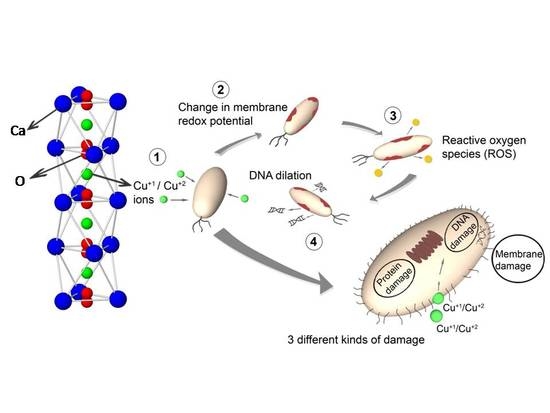Crystal Chemistry and Antibacterial Properties of Cupriferous Hydroxyapatite
Abstract
1. Introduction
2. Materials and Methods
2.1. Synthesis
2.2. Phase Confirmation and Characterisation
2.3. Antibacterial Efficacy
3. Results and Discussion
3.1. Phase Assemblages
3.2. Morphology
3.3. Copper Oxidation State
3.4. Local Structure
3.5. Antimicrobial Efficacy
4. Conclusions
Author Contributions
Funding
Acknowledgments
Conflicts of Interest
Appendix A
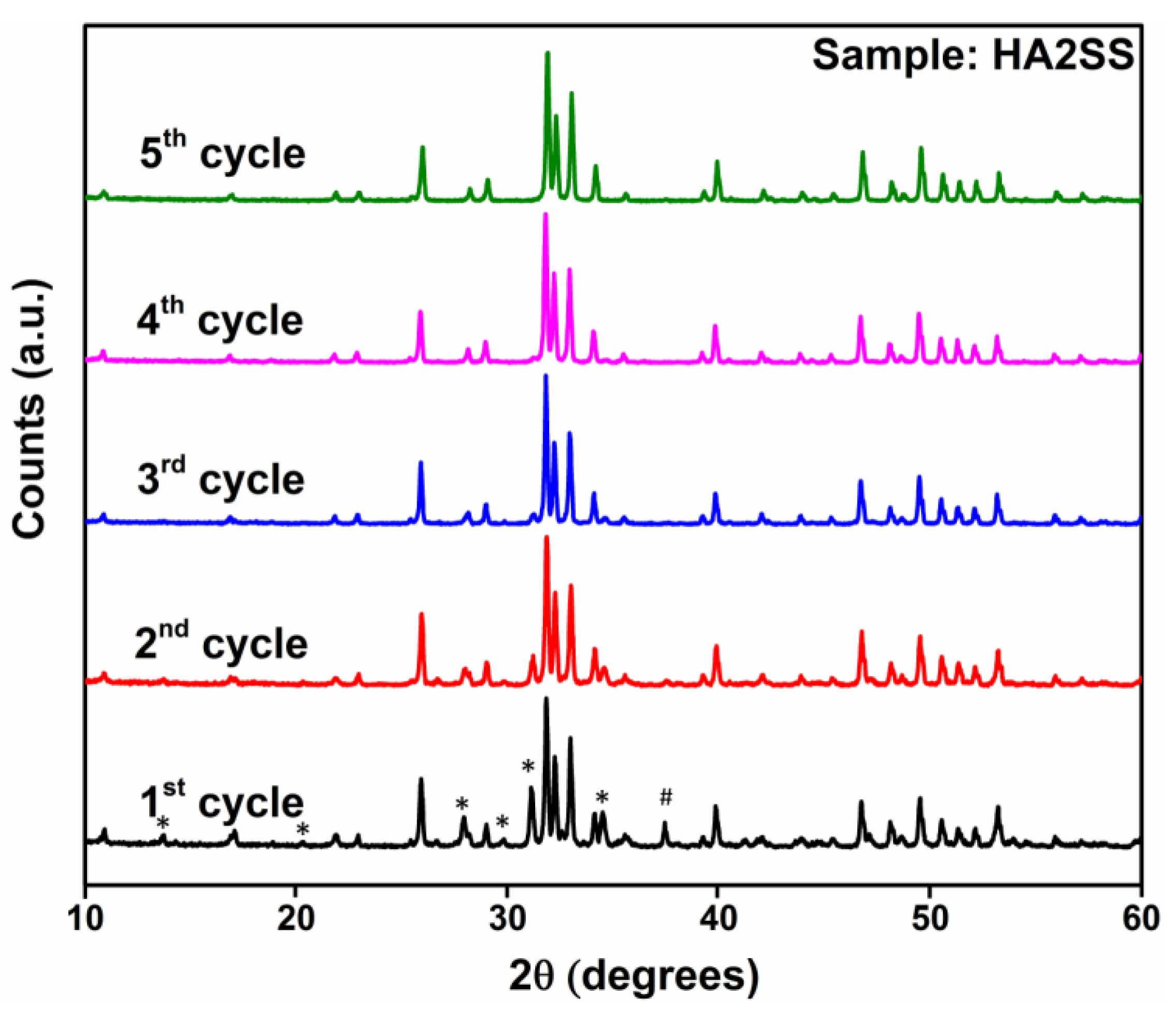
Appendix B
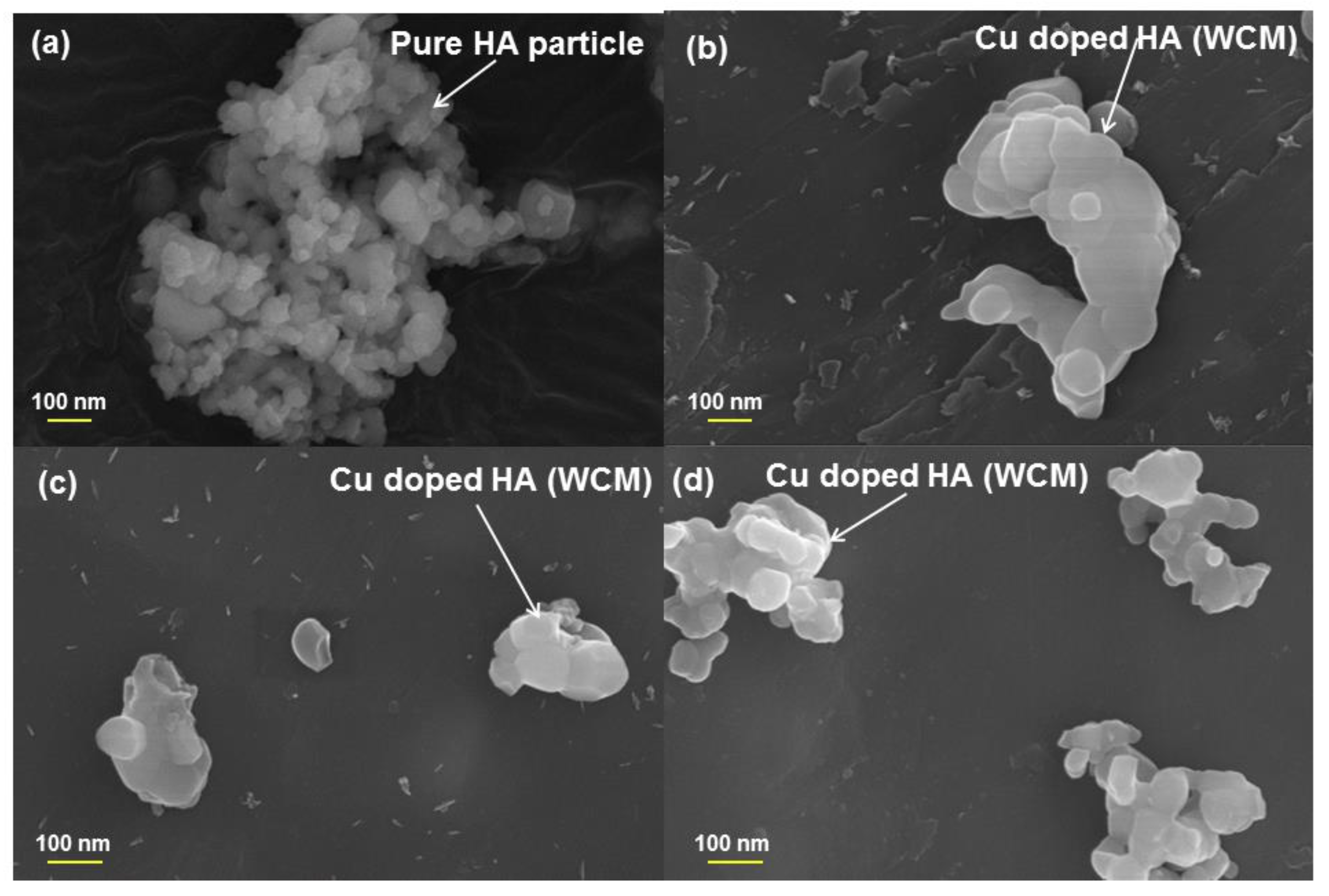
Appendix C

References
- Baikie, T.; Ng, G.M.H.; Madhavi, S.; Pramana, S.S.; Blake, K.; Elcombe, M.; White, T.J. The crystal chemistry of the alkaline-earth apatites A10(PO4)6CuxOy(H)z (A = Ca, Sr and Ba). Dalton Trans. 2009, 34, 6722–6726. [Google Scholar] [CrossRef] [PubMed]
- Kazin, P.E.; Zykin, M.A.; Dinnebier, E.E.; Magdysyuk, O.V.; Tretyakov, Y.D.; Jansen, M. An Unprecedented Process of Peroxide Ion Formation and its Localization in the Crystal Structure of Strontium Peroxy-Hydroxyapatite Sr10(PO4)6(O2)x(OH)2–2x. Z. Anorg. Allg. Chem. 2012, 638, 909–919. [Google Scholar] [CrossRef]
- White, T.; Ferraris, C.; Kim, J.; Madhavi, S. Apatite-An Adaptive Framework Structure. Rev. Mineral Geochem. 2005, 57, 307–401. [Google Scholar] [CrossRef]
- Kazin, P.E.; Karpov, A.S.; Jansen, M.; Nuss, J.; Tretyakov, Y.D. Crystal structure and properties of strontium phosphate apatite with oxocuprate ions in hexagonal channels. Z. Anorg. Allg. Chem. 2003, 629, 344–352. [Google Scholar] [CrossRef]
- Dong, Z.; White, T.J.; Wei, B.; Laursen, K. Model apatite systems for the stabilization of toxic metals: I, calcium lead vanadate. J. Am. Ceram. Soc. 2002, 85, 2515–2522. [Google Scholar] [CrossRef]
- Ben Moussa, S.; Lachheb, J.; Gruselle, M.; Maaten, B.; Kriis, K.; Kanger, T.; Tõnsuaadu, K.; Badraoui, B. Calcium, barium and strontium apatites: a new generation of catalysts in the Biginelli reaction. Tetrahedron 2017, 73, 6542–6548. [Google Scholar] [CrossRef]
- Othmani, M.; Bachoua, H.; Ghandour, Y.; Aissa, A.; Debbabi, M. Synthesis, characterization and catalytic properties of copper-substituted hydroxyapatite nanocrystals. Mater. Res. Bull. 2018, 97, 560–566. [Google Scholar] [CrossRef]
- Marrero-López, D.; Díaz-Carrasco, P.; Peña-Martínez, J.; Ruiz-Morales., J.C.; Ramos-Barrado, J.R. Lanthanum germanate-based apatites as electrolyte for SOFCs. Fuel Cells 2011, 11, 65–74. [Google Scholar]
- Shepherd, J.H.; Shepherd, D.V.; Best, S.M. Substituted hydroxyapatites for bone repair. J. Mater. Sci. Mater. Med. 2012, 23, 2335–2347. [Google Scholar] [CrossRef]
- Shannon, R.D. Revised effective ionic radii and systematic studies of interatomic distances in halides and chalcogenides. Acta Cryst. 1976, A32, 751–767. [Google Scholar] [CrossRef]
- Renaudin, G.; Gomes, S.; Nedelec, J.M. First-row transition metal doping in calcium phosphate bioceramics: a detailed crystallographic study. Materials 2017, 10, 92. [Google Scholar] [CrossRef] [PubMed]
- Karpov, A.S.; Nuss, J.; Jansen, M.; Kazin, P.E.; Tretyakov, Y.D. Synthesis, crystal structure and properties of calcium and barium hydroxyapatites containing copper ions in hexagonal channels. Solid State Sci. 2003, 5, 1277–1283. [Google Scholar] [CrossRef]
- Mercier, P.H.J.; Le Page, Y.; Whitfield, P.S.; Mitchell, L.D.; Davidson, I.J.; White, T.J. Geometrical parameterization of the crystal chemistry of P63/m apatites: comparison with experimental data and ab initio results. Acta Crystallogr. Sect. B Struct. Sci. 2005, 61, 635–655. [Google Scholar] [CrossRef] [PubMed]
- Teixeira, S.; Rodriguez, M.A.; Pena, P.; De Aza, A.H.; De Aza, S.; Ferraz, M.P.; Monteiro, F.J. Physical characterization of hydroxyapatite porous scaffolds for tissue engineering. Mater. Sci. Eng. 2009, C29, 1510–1514. [Google Scholar] [CrossRef]
- Wei, G.; Ma, P.X. Structure and properties of nano-hydroxyapatite/polymer composite scaffolds for bone tissue engineering. Biomaterials 2004, 25, 4749–4757. [Google Scholar] [CrossRef] [PubMed]
- Hoover, S.; Tarafder, S.; Bandyopadhyay, A.; Bose, S. Silver doped resorbable tricalcium phosphate scaffolds for bone graft applications. Mater Sci Eng C Mater Biol Appl. 2017, C79, 763–769. [Google Scholar] [CrossRef] [PubMed]
- Weinstein, S.I.; Yelin, E.H.; Watkins-Castillo, S.I. The Big Picture, Burden of Musculoskeletal Diseases (BMUS). Available online: http://www.boneandjointburden.org/2014-report/i0/big-picture (accessed on 5 December 2018).
- Uckay, I.; Pittet, D.; Vaudaux, P.; Sax, H.; Lew, D.; Waldvogel, F. Foreign body infections due to Staphylococcus epidermidis. Ann. Med. 2009, 41, 109–119. [Google Scholar] [CrossRef] [PubMed]
- Porter, J.R.; Ruckh, T.T.; Popat, K.C. Bone tissue engineering: a review in bone biomimetics and drug delivery strategies. Biotechnol. Prog. 2009, 25, 1539–1560. [Google Scholar] [CrossRef] [PubMed]
- Jenkins, P.J.; Phillips, S.A.; Gaston, P.; Dave, J.; Breusch, S.J. Be vigilant for secondary periprosthetic joint infection. Practitioner 2010, 254, 28–33. [Google Scholar]
- Desai, V.G. Bharatiya Rasashastra (The Ancient Chemistry of India); Gajaanan Book Depot: Mumbai, India, 1928. [Google Scholar]
- Santo, C.E.; Lam, E.W.; Elowsky, C.G.; Quaranta, D.; Domaille, D.W.; Chang, C.J.; Grass, G. Bacterial killing by dry metallic copper surfaces. Appl. Environ. Microbiol. 2011, 77, 794–802. [Google Scholar] [CrossRef]
- Grass, G.; Rensing, C.; Solioz, M. Metallic copper as an antimicrobial surface. Appl. Environ. Microbiol. 2011, 77, 1541–1547. [Google Scholar] [CrossRef] [PubMed]
- Shanmugam, S.; Gopal, B. Copper substituted hydroxyapatite and fluorapatite: Synthesis, characterization and antimicrobial properties. Ceram. Int. 2014, 40, 15655–15662. [Google Scholar] [CrossRef]
- Zykin, M.A.; Vasiliev, A.V.; Trusov, L.A.; Dinnebier, R.E.; Jansen, M.; Kazin, P.E. Solid state solubility of copper oxides in hydroxyapatite. J. Solid State Chem. 2018, 262, 38–43. [Google Scholar] [CrossRef]
- Mobasherpour, I.; Heshajin, M.S.; Kazemzadeh., A.; Zakeri, M. Synthesis of nanocrystalline hydroxyapatite by using precipitation method. J. Alloys Compd. 2007, 430, 330–333. [Google Scholar] [CrossRef]
- Gomes, S.; Vichery, C.; Descamps, S.; Martinez, H.; Kaur, A.; Jacobs, A.; Nedelec, J.M.; Renaudin, G. Cu-doping of calcium phosphate bioceramics: From mechanism to the control of cytotoxicity. Acta Biomater. 2018, 65, 462–474. [Google Scholar] [CrossRef] [PubMed]
- Coelho, A.A.; Chater, P.A.; Kern, A. Fast synthesis and refinement of the atomic pair distribution function. J. Appl. Cryst. 2015, 48, 869–875. [Google Scholar] [CrossRef]
- Massiot, D.; Fayon, F.; Capron, M.; King, I.; Le Calvé, S.; Alonso, B.; Durand, J.; Bujoli, B.; Gan, Z.; Hoatson, G. Modelling one- and two-dimensional solid-state NMR spectra. Magn. Reson. Chem. 2002, 40, 70–76. [Google Scholar] [CrossRef]
- Wang, H.; Cheng, H.; Wang, F.; Wei, D.; Wang, X. An improved 3-(4, 5-dimethylthiazol-2-yl)-2, 5-diphenyl tetrazolium bromide (MTT) reduction assay for evaluating the viability of Escherichia coli cells. J. Microbiol. Methods 2010, 82, 330–333. [Google Scholar] [CrossRef]
- Liu, G.; Talley, J.W.; Na, C.; Larson, S.L.; Wolfe, L.G. Copper doping improves hydroxyapatite sorption for arsenate in simulated groundwaters. Environ. Sci. Technol. 2010, 44, 1366–1372. [Google Scholar] [CrossRef]
- Bailliez, S.; Nzihou, A.; Beche, E.; Flamant, G. Removal of lead (Pb) by hydroxyapatite sorbent. Process Saf. Environ. Prot. 2004, 82, 175–180. [Google Scholar] [CrossRef]
- Stanić, V.; Dimitrijević, S.; Antić-Stanković, J.; Mitrić, M.; Jokić, B.; Plećaš, I.B.; Raičević, S. Synthesis, characterization and antimicrobial activity of copper and zinc-doped hydroxyapatite nanopowders. Appl. Surf. Sci. 2010, 256, 6083–6089. [Google Scholar] [CrossRef]
- Wang, C.K.; Lin, J.H.C.; Ju, C.P.; Ong, H.C.; Chang, R.P.H. Structural characterization of pulsed laser-deposited hydroxyapatite film on titanium substrate. Biomaterials 1997, 18, 1331–1338. [Google Scholar] [CrossRef]
- Kazin, P.E.; Zykin, M.A.; Zubavichus, Y.V.; Magdysyuk, O.V.; Dinnebier, R.E.; Jansen, M. Identification of the chromophore in the apatite pigment [Sr10(PO4)6(CuxOH1−x−y)2]: linear OCuO− featuring a resonance Raman effect, an extreme magnetic anisotropy, and slow spin relaxation. Chem. Eur. J. 2014, 20, 165–178. [Google Scholar] [CrossRef] [PubMed]
- De Aza, P.N.; Guitian, F.; Santos, C.; De Aza, S.; Cusco, R.; Artus, L. Vibrational properties of calcium phosphate compounds. 2. Comparison between hydroxyapatite and β-tricalcium phosphate. Chem. Mater. 1997, 9, 916–922. [Google Scholar] [CrossRef]
- Griffith, W.P. Raman spectroscopy of minerals. Nature 1969, 224, 264–266. [Google Scholar] [CrossRef]
- Rothwell, W.P.; Waugh, J.S.; Yesinowski, J.P. High-resolution variable-temperature phosphorus-31 NMR of solid calcium phosphates. J. Am. Chem. Soc. 1980, 102, 2637–2643. [Google Scholar] [CrossRef]
- Hartmann, P.; Jäger, C.; Vogel, J.; Meyer, K. Solid state NMR, X-Ray diffraction, and infrared characterization of local structure in heat-treated oxyhydroxyapatite microcrystals: an analog of the thermal decomposition of hydroxyapatite during plasma-spray procedure. J. Solid State Chem. 2001, 160, 460–468. [Google Scholar] [CrossRef]
- Duncan, J.; MacDonald, J.F.; Hanna, J.V.; Shirosaki, Y.; Hayakawa, S.; Osaka, A.; Skakle, J.M.; Gibson, I.R. The role of the chemical composition of monetite on the synthesis and properties of α-tricalcium phosphate. Mater. Sci. Eng. 2014, C34, 123–129. [Google Scholar] [CrossRef]
- Duncan, J.; Hayakawa, S.; Osaka, A.; MacDonald, J.F.; Hanna, J.V.; Skakle, J.M.; Gibson, I.R. Furthering the understanding of silicate-substitution in α-tricalcium phosphate: An X-ray diffraction, X-ray fluorescence and solid-state nuclear magnetic resonance study. Acta Biomater. 2014, 10, 1443–1450. [Google Scholar] [CrossRef]
- Mellier, C.; Fayon, F.; Schnitzler, V.; Deniard, P.; Allix, M.; Quillard, S.; Massiot, D.; Bouler, J.M.; Bujoli, B.; Janvier, P. Characterization and properties of novel gallium-doped calcium phosphate ceramics. Inorg. Chem. 2011, 50, 8252–8260. [Google Scholar] [CrossRef]
- Mellier, C.; Fayon, F.; Boukhechba, F.; Verron, E.; LeFerrec, M.; Montavon, G.; Lesoeur, J.; Schnitzler, V.; Massiot, D.; Janvier, P.; et al. Design and properties of novel gallium-doped injectable apatitic cements. Acta Biomater. 2015, 24, 322–332. [Google Scholar] [CrossRef]
- Mathews, S.; Hans, M.; Mücklich, F.; Solioz, M. Contact killing of bacteria on copper is suppressed if bacterial-metal contact is prevented and is induced on iron by copper ions. Appl. Environ. Microbiol. 2013, 79, 2605–2611. [Google Scholar] [CrossRef] [PubMed]
- Macomber, L.; Imlay, J.A. The iron-sulfur clusters of dehydratases are primary intracellular targets of copper toxicity. Proc. Natl. Acad. Sci. 2009, 106, 8344–8349. [Google Scholar] [CrossRef] [PubMed]
- Kim, T.N.; Feng, Q.L.; Kim, J.O.; Wu, J.; Wang, H.; Chen, G.C.; Cui, F.Z. Antimicrobial effects of metal ions (Ag+, Cu2+, Zn2+) in hydroxyapatite. J. Mater. Sci. Mater. Med. 1998, 9, 129–134. [Google Scholar] [CrossRef] [PubMed]

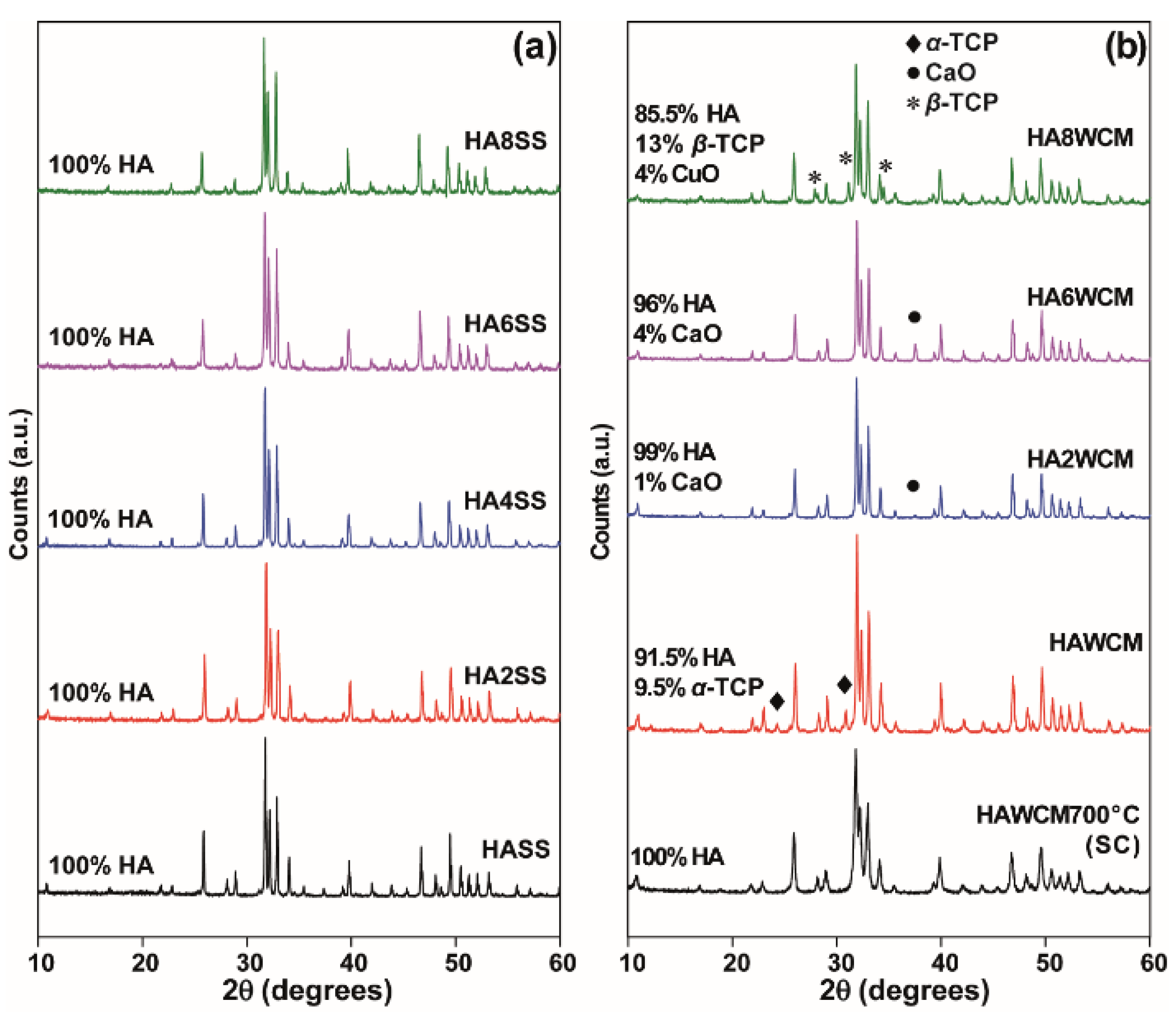
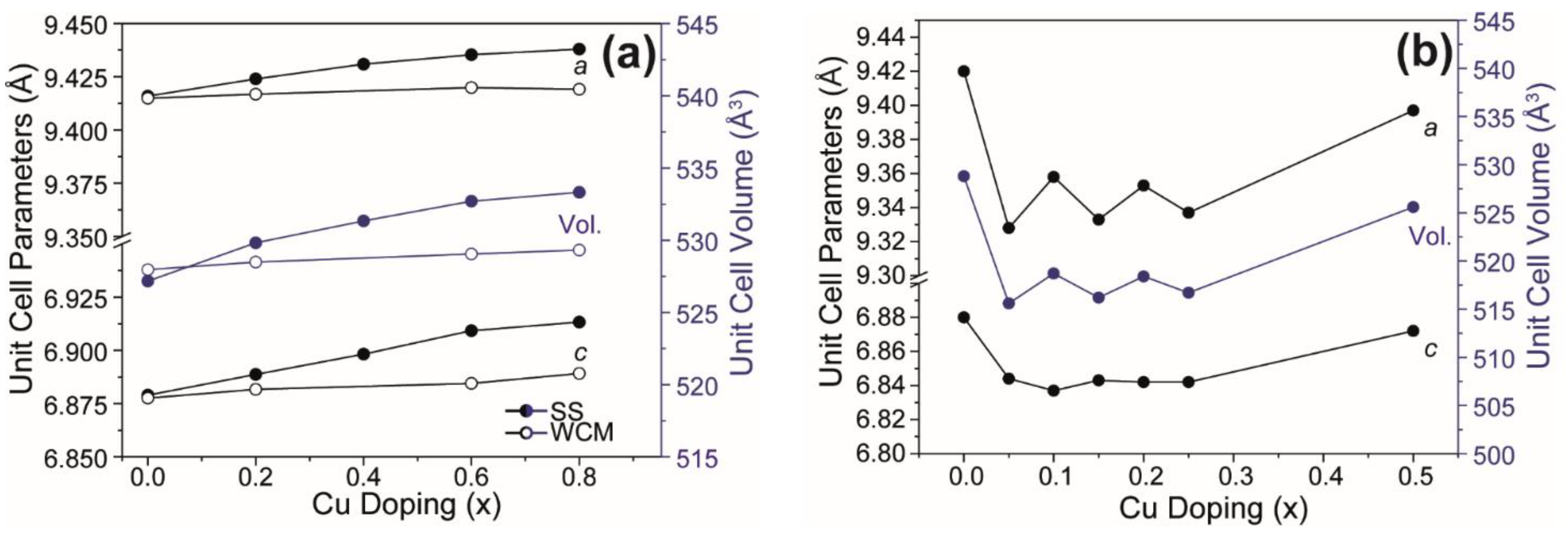
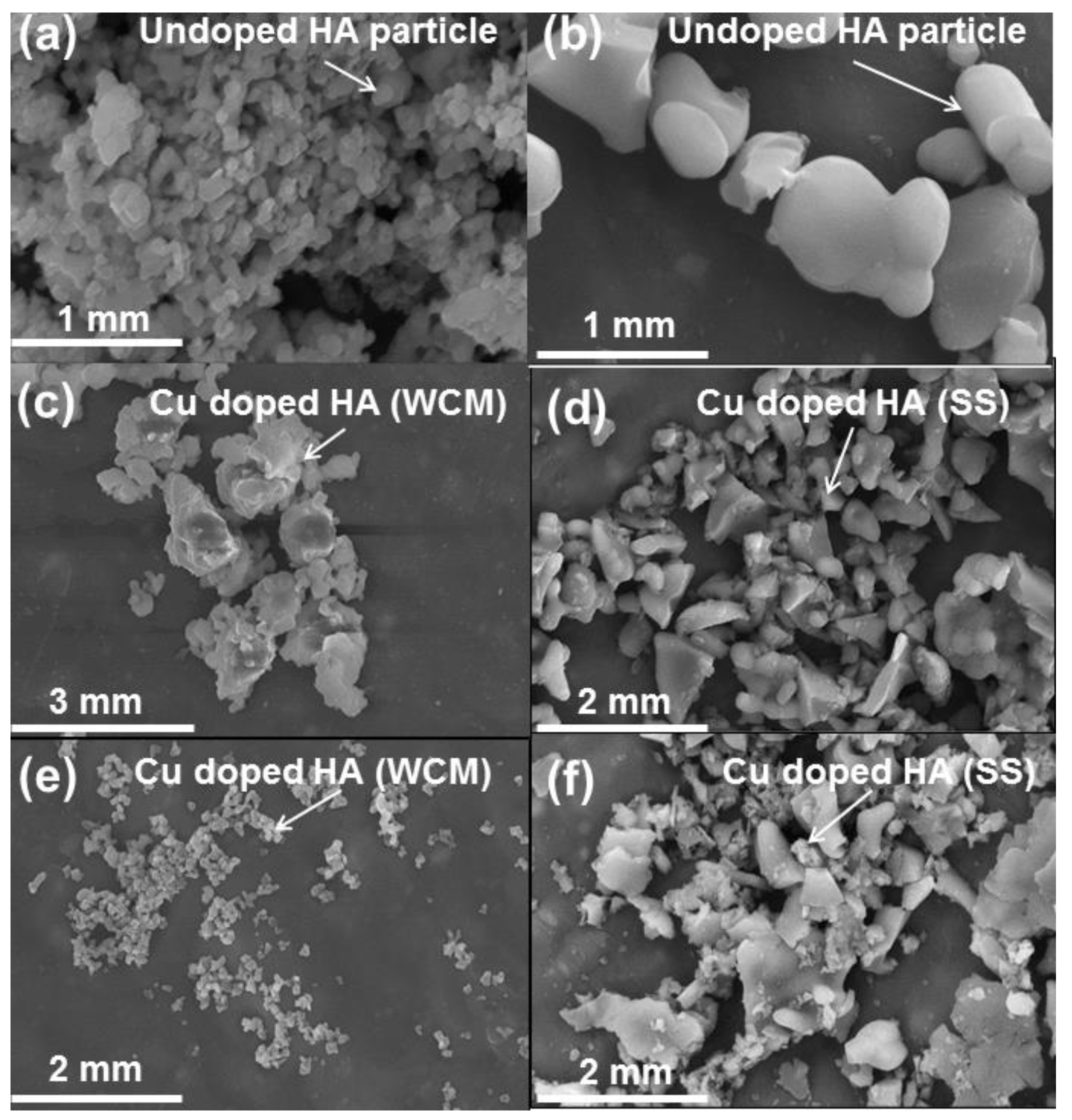
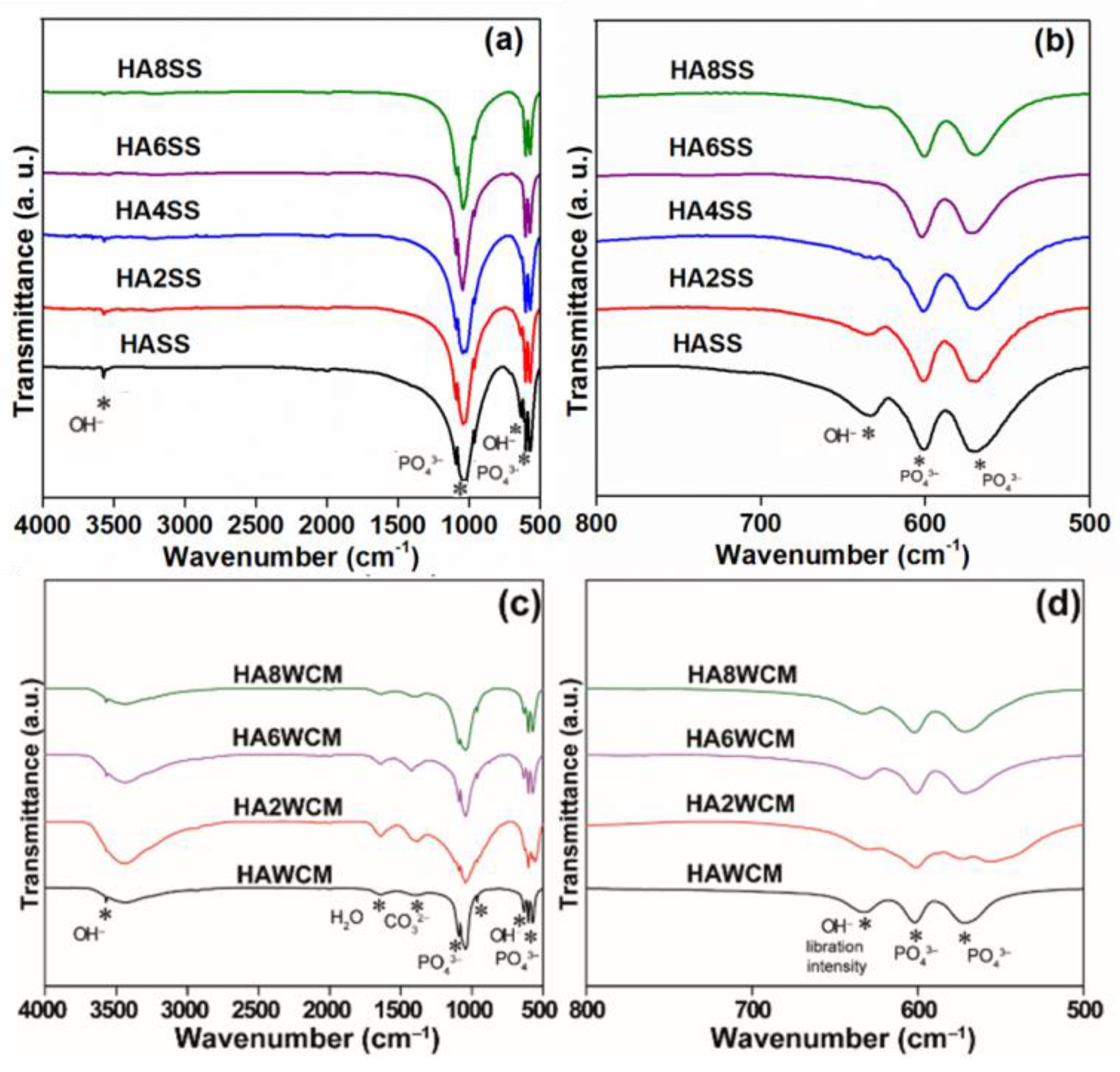
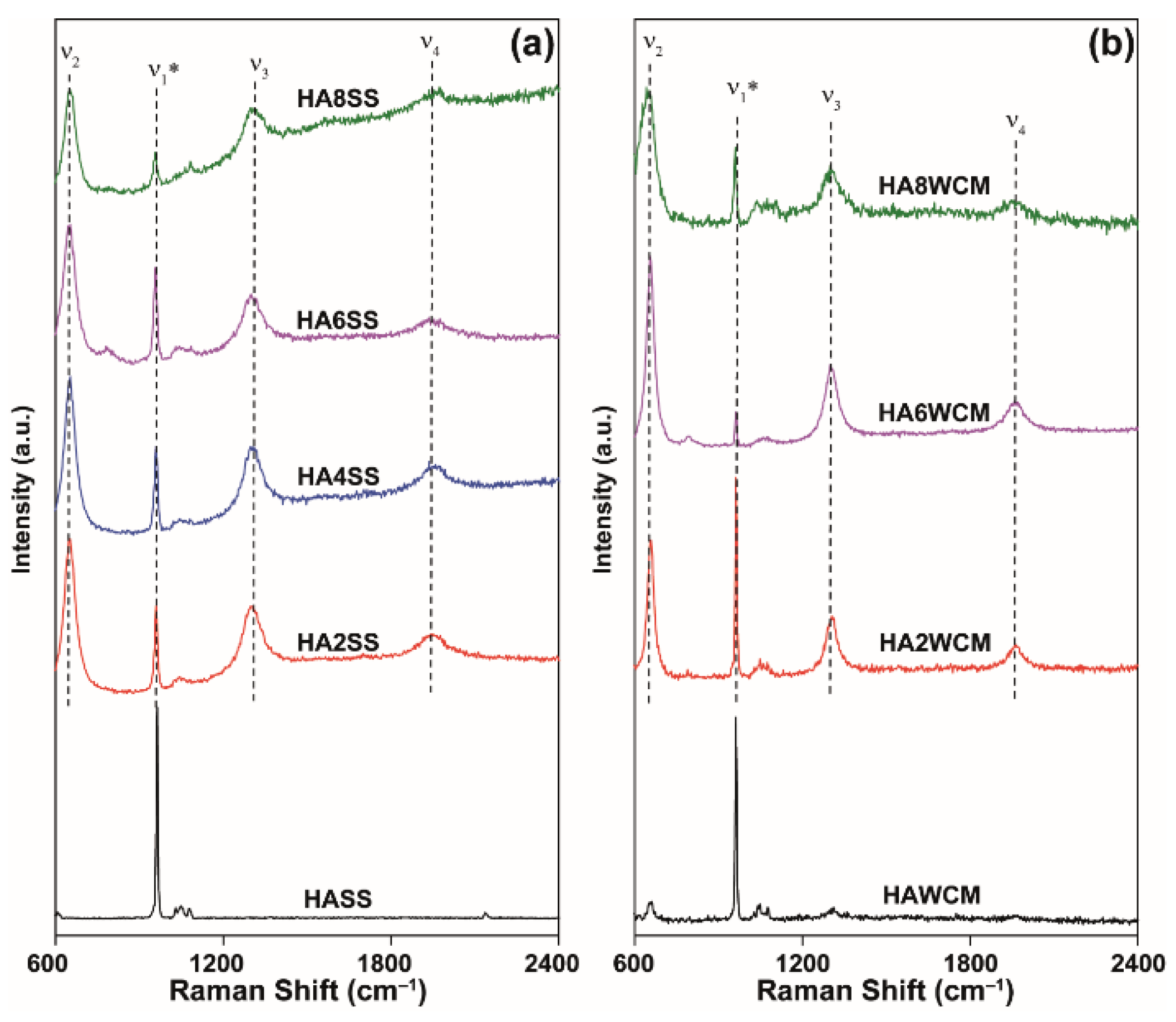


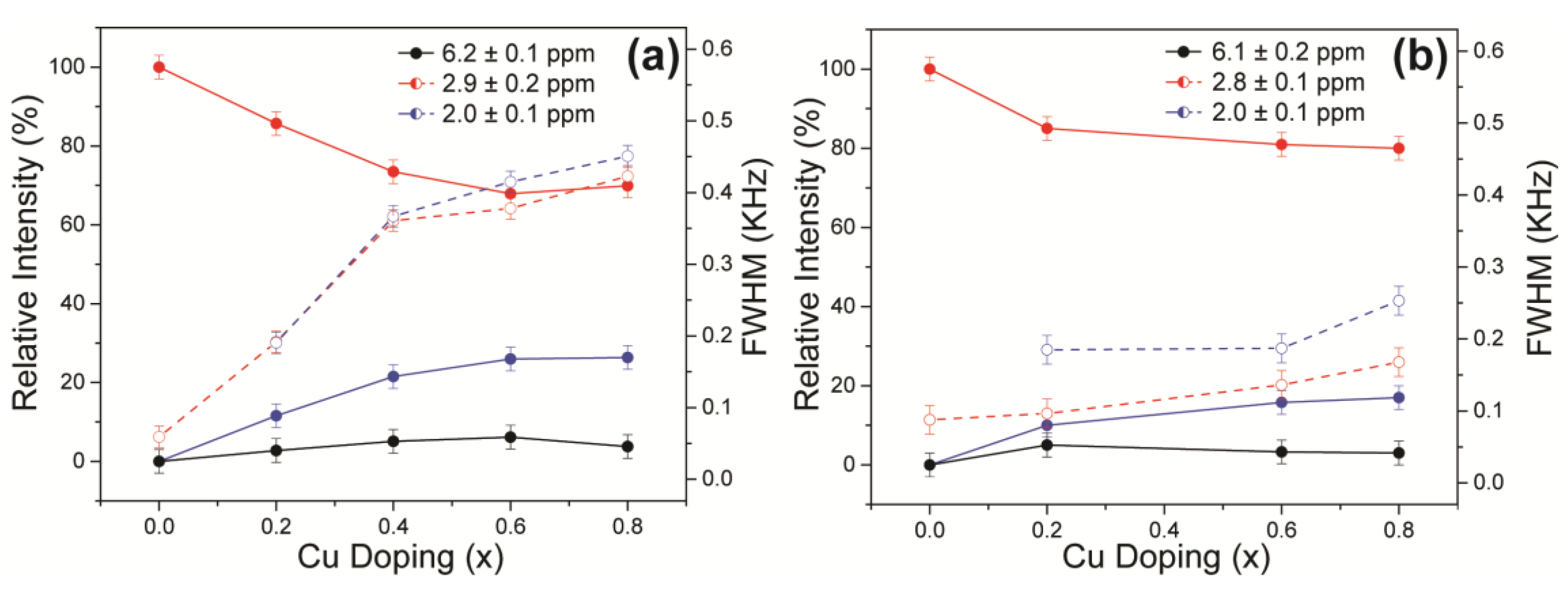
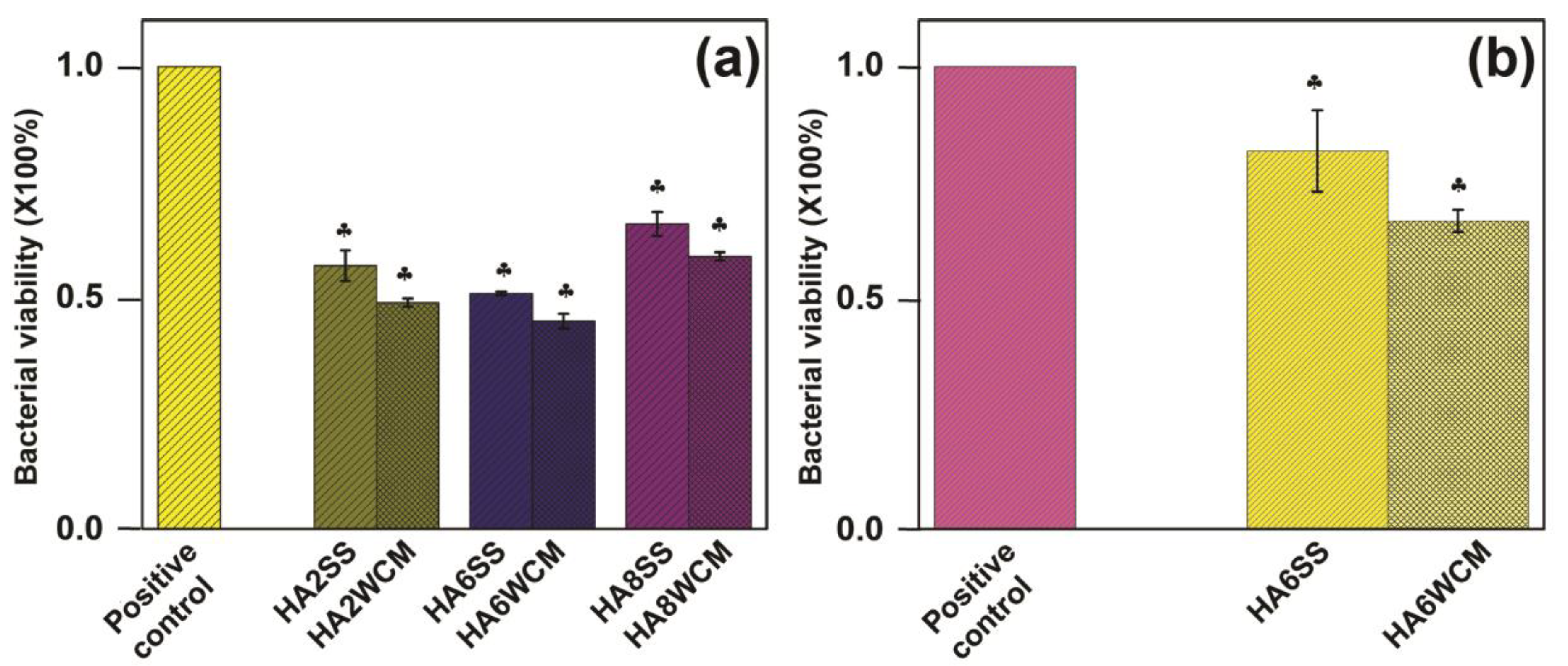
| Synthesis | Sample ID | Nominal Composition | x Nominal | a (Å) | c (Å) | V (Å3) |
|---|---|---|---|---|---|---|
| Solid State Method | HASSa | Ca10(PO4)6(OH)2 | 0 | 9.4159(3) | 6.8790(3) | 527.17(4) |
| HA2SSa | Ca10(PO4)6[Cu0.2(OH)1.6O0.2] | 0.2 | 9.4240(4) | 6.8887(3) | 529.82(5) | |
| HA4SSa | Ca10(PO4)6[Cu0.4(OH)1.2O0.4] | 0.4 | 9.4309(1) | 6.8983(1) | 531.34(2) | |
| HA6SSa | Ca10(PO4)6[Cu0.6(OH)0.8O0.6] | 0.6 | 9.4353(2) | 6.9093(2) | 532.70(3) | |
| HA6SS1b | Ca10(PO4)6[Cu0.6(OH)0.8O0.6] | 0.6 | - | - | - | |
| HA8SSa | Ca10(PO4)6[Cu0.8(OH)0.4O0.8] | 0.8 | 9.4380(3) | 6.9133(2) | 533.31(4) | |
| Wet Chemical Method | HAWCM700°Cb | Ca10(PO4)6(OH)2 | 0 | 9.4149(6) | 6.8776(5) | 527.96(8) |
| HAWCM1100°Cb | Ca10(PO4)6(OH)2 | 0 | 9.4149(6) | 6.8776(5) | 527.96(8) | |
| HAWCMa | Ca10(PO4)6(OH)2 | 0 | 9.4168(3) | 6.8792(3) | 528.30(5) | |
| HA2WCMa | Ca10(PO4)6[Cu0.2(OH)1.6O0.2] | 0.2 | 9.4168(3) | 6.8817(3) | 528.49(4) | |
| HA6WCMa | Ca10(PO4)6[Cu0.6(OH)0.8O0.6] | 0.6 | 9.4199(3) | 6.8845(3) | 529.05(4) | |
| HA8WCMa | Ca10(PO4)6[Cu0.8(OH)0.4O0.8] | 0.8 | 9.4191(3) | 6.8892(3) | 529.32(5) |
| Synthesis | Sample ID | Nominal Composition | x Nominal | δ (31P) (ppm) (±0.1) | FWHM (kHz) (±0.01) | Relative Intensityc (kHz) (±2) |
|---|---|---|---|---|---|---|
| Solid-State Method | HASSa | Ca10(PO4)6(OH)2 | 0 | 6.0 | 0.11 | 1 |
| 2.7 | 0.06 | 99 | ||||
| HA2SSa | Ca10(PO4)6[Cu0.2(OH)1.6O0.2] | 0.2 | 6.2 | 0.28 | 3 | |
| 2.9 | 0.24 | 83 | ||||
| 2.1 | 0.21 | 14 | ||||
| HA4SSa | Ca10(PO4)6[Cu0.4(OH)1.2O0.4] | 0.4 | 6.3 | 0.29 | 6 | |
| 3.0 | 0.33 | 65 | ||||
| 2.1 | 0.34 | 30 | ||||
| HA6SSa | Ca10(PO4)6[Cu0.6(OH)0.8O0.6] | 0.6 | 6.2 | 0.31 | 5 | |
| 3.0 | 0.38 | 67 | ||||
| 2.0 | 0.40 | 28 | ||||
| HA8SSa | Ca10(PO4)6[Cu0.8(OH)0.4O0.8] | 0.8 | 6.2 | 0.31 | 6 | |
| 3.0 | 0.42 | 67 | ||||
| 1.9 | 0.45 | 27 | ||||
| Wet Chemical Method | HAWCM700°Cb | Ca10(PO4)6(OH)2 | 0 | 2.7 | 0.04 | 100 |
| HAWCM1100°Cb | Ca10(PO4)6(OH)2 | 0 | 2.7 | 0.04 | 100 | |
| HA2WCMa | Ca10(PO4)6[Cu0.2(OH)1.6O0.2] | 0.2 | 6.2 | 0.15 | 5 | |
| 2.8/3.0 | 0.10 | 85 | ||||
| 2.0 | 0.19 | 10 | ||||
| 0.2 | 0.41 | - | ||||
| HA6WCMa | Ca10(PO4)6[Cu0.6(OH)0.8O0.6] | 0.6 | 6.2 | 0.24 | 3 | |
| 2.8/3.0 | 0.11 | 81 | ||||
| 2.1 | 0.49 | 16 | ||||
| HA8WCMa | Ca10(PO4)6[Cu0.8(OH)0.4O0.8] | 0.8 | 5.9 | 0.18 | 3.0 | |
| 2.9/3.1 | 0.17 | 80.0 | ||||
| 2.1 | 0.21 | 17 | ||||
| 0.3 | 0.26 | - |
© 2019 by the authors. Licensee MDPI, Basel, Switzerland. This article is an open access article distributed under the terms and conditions of the Creative Commons Attribution (CC BY) license (http://creativecommons.org/licenses/by/4.0/).
Share and Cite
Bhattacharjee, A.; Fang, Y.; Hooper, T.J.N.; Kelly, N.L.; Gupta, D.; Balani, K.; Manna, I.; Baikie, T.; Bishop, P.T.; White, T.J.; et al. Crystal Chemistry and Antibacterial Properties of Cupriferous Hydroxyapatite. Materials 2019, 12, 1814. https://doi.org/10.3390/ma12111814
Bhattacharjee A, Fang Y, Hooper TJN, Kelly NL, Gupta D, Balani K, Manna I, Baikie T, Bishop PT, White TJ, et al. Crystal Chemistry and Antibacterial Properties of Cupriferous Hydroxyapatite. Materials. 2019; 12(11):1814. https://doi.org/10.3390/ma12111814
Chicago/Turabian StyleBhattacharjee, Arjak, Yanan Fang, Thomas J. N. Hooper, Nicole L. Kelly, Disha Gupta, Kantesh Balani, Indranil Manna, Tom Baikie, Peter T. Bishop, Timothy J. White, and et al. 2019. "Crystal Chemistry and Antibacterial Properties of Cupriferous Hydroxyapatite" Materials 12, no. 11: 1814. https://doi.org/10.3390/ma12111814
APA StyleBhattacharjee, A., Fang, Y., Hooper, T. J. N., Kelly, N. L., Gupta, D., Balani, K., Manna, I., Baikie, T., Bishop, P. T., White, T. J., & Hanna, J. V. (2019). Crystal Chemistry and Antibacterial Properties of Cupriferous Hydroxyapatite. Materials, 12(11), 1814. https://doi.org/10.3390/ma12111814




